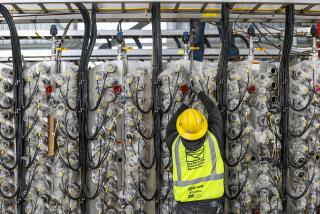Lockheed’s Effort to Sell Properties in Burbank Rests on Toxic Cleanup : Real estate: The company’s plans to remove pollution remain unclear. Potential buyers say they want a clean site.
- Share via
Lockheed Corp. is trying to sell 250 of its 300 acres of property in Burbank, and the nearby Burbank Airport is mulling whether to buy some of the land to expand its passenger terminal.
But there’s a problem--the land and nearby ground water are contaminated with the residue of toxic chemicals. Robert Garcin, president of the Burbank-Glendale-Pasadena Airport Authority, which owns the Burbank facility, bluntly said “we want a clean site” before any sale is made “and the burden of giving us a clean site is on the seller.”
“If I can’t use it, I don’t want it,” Garcin said.
The airport’s posture illustrates the tricky problems faced by Lockheed in selling the land, which the aerospace giant is leaving in favor of shifting major military aircraft projects to its plants in Palmdale and in Marietta, Ga. Although the company says potential buyers are stepping forward with “acceptable prices,” the sale of various parcels won’t be a matter of simply exchanging cash for land.
Lockheed’s complex is spread over roughly four plants and includes its secret Skunk Works advanced development division, its composites technology center and other facilities where toxic chemicals were long used. The company says it stands ready to spend at least $50 million to clean up the area’s pollution, but it’s still unclear whether others will help, how long the cleanup will take and how many millions of dollars it will eventually cost.
Like Garcin, anyone thinking of buying the land wouldn’t want to inherit any leftover liability for cleaning up the site. Until the cleanup effort is clarified, some would-be buyers might sit tight or ask Lockheed to indemnify them against any future liability.
“None of our developer clients are anxious to build there,” said Mike Zugsmith, president of Zugsmith & Associates, a commercial real estate brokerage in Studio City.
Lockheed previously has said it is aware that potential buyers will want protection from liability, and that such protection will have to be resolved as it tries to sell each parcel. Spokesman Scott Hallman said last week: “Lockheed intends to clean up the property as a condition of sale,” but he said the company would not elaborate.
“We’re telling clients that somehow, some way, that property is going to be available, but beyond that there isn’t a whole lot to say,” said Seth Dudley, Encino branch manager and vice president of Julien J. Studley Inc., another real estate broker.
Further clouding the issue for potential buyers is the city of Burbank, which is planning to rezone Lockheed’s land and the surrounding area. Burbank officials want to block new heavy-polluting manufacturers from moving to the site, and therefore they want it for “clean” light industry, office buildings and retail outlets, City Planner Rick Pruetz said.
For now, Lockheed is entitled to try to sell the land to whomever it wishes, hoping that it gets city approval, Pruetz said. But some developers and other potential buyers might wait until the final zoning is approved--which could be up to 18 months away--before deciding whether to bid for Lockheed’s property.
“The city’s decisions in general about that property will affect the pool of buyers and the price,” Dudley said. “The common speculation is that Lockheed, while they’re interested in talking to potential buyers, will need to wait and see what the city’s disposition is.”
Lockheed’s costs of spearheading the toxic cleanup also could vastly diminish its profit from selling the land. Lockheed said a year ago that its pretax proceeds from the sale could be roughly $200 million, or $800,000 an acre. But Lockheed’s cleanup tab might reach $100 million or more, depending on how the cleanup is structured and how long it takes.
Lockheed itself seems confident. In the company’s 1990 annual report, about to be mailed to stockholders, Vice Chairman Vincent N. Marafino reports “good progress” in selling the land.
“We have offers to purchase a substantial portion of these properties at acceptable prices, and negotiations are under way,” he stated, adding that the sales should be completed by 1993. Lockheed is not elaborating on what Marafino meant by “substantial” and is not speculating on how the property will be used after it is sold, Hallman said.
Lockheed’s land certainly has some favorable attributes. It’s situated in a city where commercial properties, notably office space, are in short supply. The land also is next to the airport and the Golden State Freeway.
Lockheed also got a bit of a break last week when Burbank voters rejected three measures to control commercial growth. Had the measures passed, the number of potential buyers of Lockheed’s land might have been curbed as well.
The company announced last May 8 that it was pulling most of its operations out of Burbank, where the aerospace division has been based. Burbank also served as Lockheed’s corporate headquarters until a few years ago, when it was moved to Calabasas.
Fully aware of the site’s pollution problem, Lockheed in 1989 offered to pay $52 million toward a cleanup of Burbank water supply wells under the federal Superfund law, which allows the U.S. Environmental Protection Agency to extract cleanup costs and damages from firms responsible for toxic pollution. But the EPA and Lockheed have yet to reach a final agreement on the plan.
Nonetheless, Lockheed’s “outside consultants currently estimate that soil cleanup will cost a total of about $10 million to $25 million,” Hallman said, and that “ground-water cleanup costs are estimated to cost Lockheed about $10 million annually.” Asked how many years the ground-water cleanup would take, Hallman said “that’s an issue that has not been nailed down.”
Among those wanting the issue resolved are banks and other lenders that might bankroll developers’ plans to buy Lockheed’s land. Lenders generally worry that if their borrowers default on loans for contaminated property, they will have to foreclose and take title to the property--making them potentially liable for the site’s cleanup. Given the troubles already besetting banks and thrifts, that’s the last thing they want.
Last month, the EPA proposed a rule to limit the liability of banks in such situations. But for now, “you want to be indemnified as long as you have anything to do with the property,” unless the bank is convinced that the site can be cleaned up before it makes the loan, said Don Hinton, senior credit officer at Imperial Bank’s real estate division.
“It’s important not to become so concerned with that issue that you fail to focus on the economics driving the deal,” Hinton said.
The Burbank Airport’s Garcin noted that the site for a new terminal must be clean because 80% of the money to buy the land would come from the federal government, which will demand that pollution be removed. In the meantime, he said the airport--which used to be owned by Lockheed and is still operated by a Lockheed division--is negotiating with Lockheed and preparing an environmental impact report on the property.
The airport also is weighing other sites for expanding its terminal. But if need be, “I think I can do business with Lockheed,” Garcin said. “I think I can get a clean site from them.”
More to Read
Inside the business of entertainment
The Wide Shot brings you news, analysis and insights on everything from streaming wars to production — and what it all means for the future.
You may occasionally receive promotional content from the Los Angeles Times.











